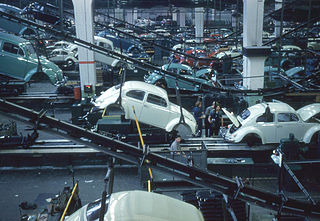
Manfred Winkelhock was a German racing driver, who competed in Formula One between 1980 and 1985.

A supercar, also known as an exotic car, is a type of automobile generally described at its most basic as a street-legal sports car with race track-like power, speed, and handling, plus a certain subjective cachet linked to pedigree, exclusivity, or both. The term 'supercar' is frequently used for the extreme fringe of powerful, low-bodied mid-engine luxury sportscars. A low car has both a low, handling-favorable center of gravity, and less frontal area than a front engined car, reducing its aerodynamic drag and enabling a higher top speed. Since the 2000s, the term hypercar has come into use for the highest performance supercars.

The land speed record (LSR) or absolute land speed record is the highest speed achieved by a person using a vehicle on land. By a 1964 agreement between the Fédération Internationale de l'Automobile (FIA) and Fédération Internationale de Motocyclisme (FIM), respective governing bodies for racing in automobiles and motorcycles, both bodies recognise as the absolute LSR whatever is the highest speed record achieved across any of their various categories. While the three-wheeled Spirit of America set an FIM-validated LSR in 1963, all subsequent LSRs are by vehicles in FIA Category C in either class JE or class RT.

ThrustSSC, Thrust SSC or Thrust SuperSonic Car is a British jet car developed by Richard Noble, Glynne Bowsher, Ron Ayers, and Jeremy Bliss. Thrust SSC holds the world land speed record, set on 15 October 1997, and driven by Andy Green, when it achieved a speed of 1,228 km/h (763 mph) and it became the first and only land vehicle to officially break the sound barrier.
Gary Michael Gabelich was an American motorsport driver who set the Fédération Internationale de l'Automobile (FIA) Land Speed Record (LSR) with the rocket car Blue Flame on October 23, 1970, on a dry lake bed at Bonneville Salt Flats near Wendover, Utah.

Brabus GmbH is a German high-performance automotive aftermarket tuning company founded in 1977 in Bottrop. Brabus specialises mainly in Mercedes-Benz, Maybach and Smart vehicles. They have also modified other vehicles including Porsche.

Hal Brett Needham was an American stuntman, film director, actor, writer, and NASCAR team owner. He is best known for his frequent collaborations with actor Burt Reynolds, usually in films involving fast cars, such as Smokey and the Bandit (1977), Hooper (1978), The Cannonball Run (1981) and Stroker Ace (1983).
Teodorico "Teo" Fabi is an Italian former racing driver, who competed in Formula One from 1982 to 1987. In sportscar racing, Fabi won the World Sportscar Championship in 1991 with Jaguar.

The Motor Trend Car of the Year (COTY) is an annual Car of the Year award given by Motor Trend magazine to recognize the best new or significantly refreshed car in a given model year.

A spoiler is an automotive aerodynamic device whose intended design function is to 'spoil' unfavorable air movement across the body of a vehicle in motion, usually manifested as lift, turbulence, or drag. Spoilers on the front of a vehicle are often called air dams.

Ruf Automobile GmbH is a German car manufacturer. Formerly using Porsche bodies in white to build cars, today they build vehicles on their own bodies and chassis. They also manufacture performance parts for various Porsche models, including the 911, Boxster, and Cayman.

The Petersen Automotive Museum is an automobile museum located on Wilshire Boulevard along Museum Row in the Miracle Mile neighborhood of Los Angeles. One of the world's largest collections, the Petersen Automotive Museum is a nonprofit organization specializing in automobile history and related educational programs.

Production vehicles or production cars are mass-produced models of automobiles offered for sale to the public and can be legally driven on public roads. Legislation and other industrial rules define the production vehicle within particular countries or uses. There is no single fixed global definition of the term.

Stan Barrett is a Hollywood stuntman, stunt coordinator actor, and former stock car racing driver. His biggest act was however outside the movie world. On December 17, 1979, he attempted to break the land speed record, and the sound barrier in the Budweiser Rocket rocket-powered three-wheel vehicle. His calculated speed was 739.666 miles per hour,, which would have made Barrett the first man to break the sound barrier in a land vehicle. The attempt was surrounded by controversy and the speed was never officially recorded. Barrett also raced in 19 Winston Cup Series races between 1980 and 1990, posting two top ten finishes.

Waldo Stakes is an American general contractor and designer of high speed vehicles. Stakes is planning to break the world land speed record using a rocket car powered by a second-hand X-15 rocket engine, which he has named the Sonic Wind Land Speed Research Vehicle.

9ff is a German car tuning company based in Dortmund. It was founded by Jan Fatthauer in 2001. It specializes in converting stock Porsches into street legal racing vehicles, either as fully tuned cars, or by selling individual parts or kits. The company is best known for building one of the first cars to exceed 400 km/h (249 mph), the GT9, capable of 256 mph (412 km/h). The former company, 9ff Fahrzeugtechnik GmbH, filed for bankruptcy in September 2013. A new company, 9ff Engineering GmbH was founded in October 2013.

1950s American automobile culture has had an enduring influence on the culture of the United States, as reflected in popular music, major trends from the 1950s and mainstream acceptance of the "hot rod" culture. The American manufacturing economy switched from producing war-related items to consumer goods at the end of World War II, and by the end of the 1950s, one in six working Americans were employed either directly or indirectly in the automotive industry. The United States became the world's largest manufacturer of automobiles, and Henry Ford's goal of 30 years earlier—that any man with a good job should be able to afford an automobile—was achieved. A new generation of service businesses focusing on customers with their automobiles came into being during the decade, including drive-through or drive-in restaurants and greatly increasing numbers of drive-in theaters (cinemas).

Romain Dumas is a French racing driver and driver for Glickenhaus in the World Endurance Championship. He first started out in karting and single-seater before becoming an expert driver in endurance racing, GT and sport-prototype. He has won the greatest races of the discipline, such as the 24 Hours of Le Mans, the 24 Hours of Spa, the Nürburgring 24 Hours, and the 12 Hours of Sebring. He has been one of Porsche's factory drivers since 2004. He's also been contracted to Audi from 2009 to 2012, Volkswagen from 2017 to 2019, and Ford Performance since 2022. Adding to this, Dumas is a Chopard ambassador.

Hollywood actor James Dean was killed at the age of 24 in an auto accident on September 30, 1955, near Cholame, California. He had previously competed in several auto racing events, and was traveling to a sports car racing competition when he was involved in a car crash at the junction of U.S. Route 466 and SR 41.


















